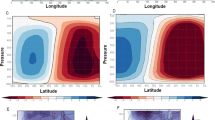Abstract
The atmospheric angular momentum (AAM) functions in terms of contribution to polar wobble and length of day change, are calculated from the output data of GSM9603 global circulation model (GCM) of Japan Meteorological Agency (JMA), from the reanalysis data of the National Centers for the Environmental Prediction (NCEP)/National Center for Atmospheric Research (NCAR), and from the operational objective analysis data of JMA, respectively. The comparison shows that during the period from 1985 to 1995, the values of the pressure terms in the equatorial components of AAM functions calculated from three data sets agree with each other better along 90°E longitude than along Greenwich meridian direction. The axial component of relative AAM function estimated from GSM 9603 agrees well with those from the other two data sets in terms of seasonal variations with the moderate amplitudes, but not so well with the composite axial component of relative AAM functions estimated from 23 GCM models anticipating in the first phase of AMIP. In addition, its interannual variation from 1979 to 1996 shows the main characteristics of ENSO evolution, just as does the axial component of relative AAM function estimated from NCEP reanalysis data except for the period of anomalous ENSO from 1991 to 1993.
Similar content being viewed by others
References
Aoyama Y., and I. Naito, 2000: Wind contribution to the Earth’s angular momentum budgets in seasonal variation. J. Geophys. Res., 105, 12417–12432.
Barnes, R. T., H. R. Hide, A, A. White, and C. A. Wilson, 1983: Atmospheric angular momentum fluctuation, length of day changes and polar motion. Proc. Roy. Soc. London, 387 (Ser. A), 31–73.
Eubanks, T. M., J. A. Steppe, J. O. Dickey, R. D. Rosen, and D. A. Salstein, 1988: Causes of rapid motions of the Earth’s pole. Nature, 334, 115–119.
Eubanks, T. M, 1993: Variation in the orientation of the Earth. Contribution of Space Geodesy to Geodynamics, Geodyn. Ser., AGU, Washington, D. C, 24, 1–54.
Gross, R. S., and U. J. Lindqwister, 1992: Atmospheric excitation of polar motion during the GIG’91 measurement campaign. Geophys. Res. Lett., 19, 849–852.
Gates, W. L., J. S. Boyle, and C. Covey, 1999: An overview of the results of the Atmospheric Model Inter-comparison Project (AMIP I). Bull. Amer. Meteor. Soe., 80, 29–55.
Lambeck, K., 1980: The Earth Variable Rotation, Cambridge Univ. Press, New York, 449pp.
Munk W. H., and G. Macdonald, 1960: The Rotation of the Earth, Cambridge Univ. Press, New York, 323pp.
Naito, I., N. Kikuchi, and K. Yokoyama, 1987: Results of estimating the atmospheric effective angular momentum functions based on the JM A global analysis data. Publ. Int. Latitude Obs. Mizusawa, 20, 1–11.
Hide, R., J. O. Dickey, S. L. Marcus, R. D. Rosen, and D. A. Salstein, 1997: Atmospheric angular momentum fluctuations during 1979–1988 simulated by global circulation models. J. Geophys. Res., 102, 16423–16438.
Rosen, R. D., D. A. Salstein, and T. M. Wood, 1991b: Zonal contributions to global momentum variations on intra-seasonal through inter-annual timescales. J. Geophys. Res., 96, 5145–5151.
Rosen, R. D., and D. A. Salstein, 1985: Contribution of stratospheric winds to annual and semiannual fluctuations in atmospheric angular momentum and the length of day. J. Geophys. Res., 90, 8033–8041.
Rosen, R. D., 1993: The axial momentum balance of Earth and its fluid envelope. Surv. Geophys., 14, 1–29.
Zhong M., I. Naito, and A. Kitoh, 2002: Atmospheric, oceanic, and hydrologic contributions to annual wobble calculated from COAGCM data. (accepted by J. Geophys. Res.).
Author information
Authors and Affiliations
Additional information
This work was supported by the National Natural Science Foundation of China under Grant Nos. 49904002 and 40074004, the National Climbing Project of China under Grant No. 970231003, and LASG, Institute of Atmospheric Physics, Chinese Academy of Sciences.
Rights and permissions
About this article
Cite this article
Min, Z., Haoming, Y. & Yaozhong, Z. The investigation of atmospheric angular momentum as a contributor to polar wobble and length of day change with AMIP II GCM data. Adv. Atmos. Sci. 19, 287–296 (2002). https://doi.org/10.1007/s00376-002-0023-y
Received:
Revised:
Issue Date:
DOI: https://doi.org/10.1007/s00376-002-0023-y




